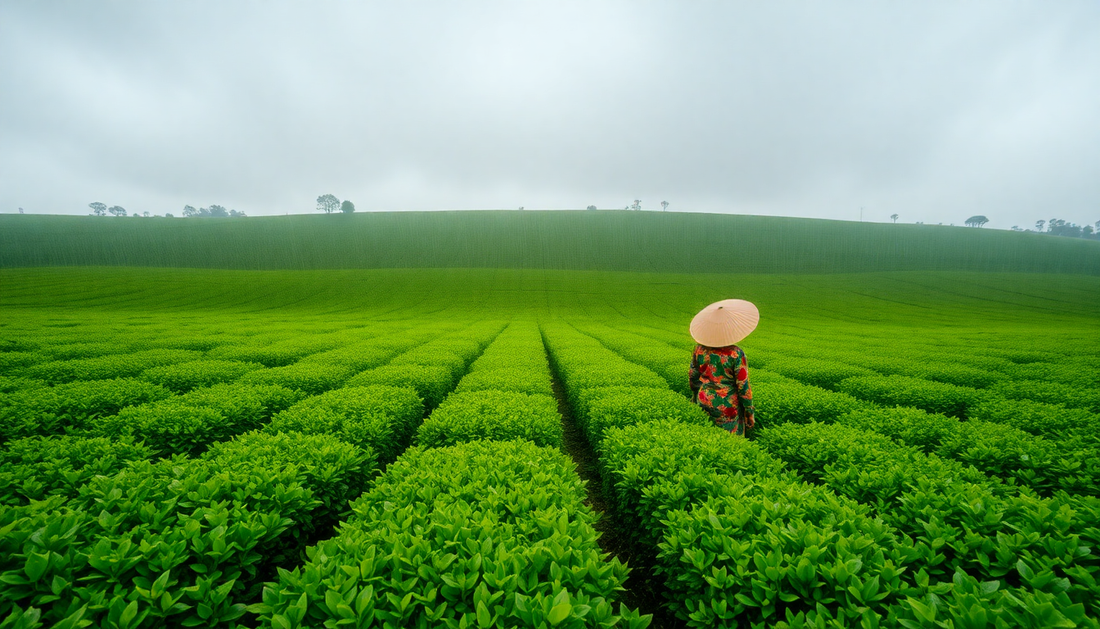
Exploring the Influence of Climate on Tea Flavors
ZenBrew Tea StudioTea is one of the world's most beloved beverages, enjoyed by millions for its rich flavors, soothing aromas, and potential health benefits. As the second most consumed drink globally after water, tea has become an integral part of many cultures and lifestyles. However, the diverse range of tea flavors we experience is not solely a result of the tea plant itself, but rather a reflection of the intricate interplay between the plant and its growing environment.
At the heart of this relationship lies the profound influence of climate on the development and expression of tea's unique characteristics. From the misty highlands of Sri Lanka to the sun-drenched plains of China, the subtle nuances in temperature, rainfall, altitude, and sunlight all contribute to the creation of tea's captivating flavor profiles. Understanding this dynamic connection between climate and tea is not only fascinating but also essential for tea enthusiasts and connoisseurs alike.
The Climate Factors Shaping Tea Flavors
Tea plants are remarkably sensitive to their surrounding environment, and the climate in which they are grown plays a pivotal role in determining the final flavor of the tea leaves. Let's explore the key climatic factors that shape the taste and aroma of this beloved beverage.
Temperature
Temperature is a crucial factor in tea cultivation, as it directly affects the growth, maturation, and chemical composition of the tea leaves. Cooler temperatures, often found in high-altitude regions, tend to produce teas with a more delicate, subtle flavor profile, such as the renowned green teas of Japan and the high-mountain oolongs of Taiwan. Conversely, warmer climates, like those found in the lowland tea gardens of Assam, India, can result in bolder, more robust black teas with a full-bodied character.
Rainfall

The amount and distribution of rainfall throughout the year also have a significant impact on tea flavors. Regions with abundant rainfall, like the lush, tropical areas of Sri Lanka, often yield teas with a bright, refreshing acidity and a distinct floral or fruity note. In contrast, tea plants grown in drier climates, such as the arid regions of China's Yunnan province, can develop a more concentrated, earthy, and sometimes slightly sweet flavor profile.
Altitude
The elevation at which tea is grown is another crucial factor in shaping its flavor. High-altitude tea gardens, often found in mountainous regions, tend to produce teas with a more delicate, refined character. The cooler temperatures and increased exposure to sunlight at higher elevations can result in teas with a more pronounced sweetness, a vibrant aroma, and a complex, nuanced flavor. Lower-altitude teas, on the other hand, may exhibit a more robust, full-bodied taste.
Sunlight

The amount of sunlight a tea plant receives during its growth cycle can also have a significant impact on the final flavor. Teas grown in regions with abundant sunlight, like the sun-drenched tea gardens of Kenya, often develop a deeper, more intense color and a more pronounced, sometimes slightly astringent, flavor. Conversely, teas grown in shaded environments, such as the renowned Japanese gyokuro green tea, can exhibit a more delicate, umami-rich taste.
Major Tea-Growing Regions and Their Climates
The world's major tea-producing regions are each characterized by their unique climatic conditions, which in turn shape the distinct flavor profiles of the teas they yield.
China

China, the birthplace of tea, is renowned for its diverse tea-growing regions, each with its own distinct climatic characteristics. From the lush, subtropical regions of Fujian and Zhejiang, which produce the delicate and fragrant green teas, to the high-altitude, cool-climate areas of Yunnan, which are famous for their robust, earthy pu-erh teas, the climate of China plays a pivotal role in the country's tea diversity.
India

India, another major tea-producing powerhouse, is home to several renowned tea-growing regions, each with its own climatic profile. The Assam region, with its warm, humid climate, is known for its full-bodied, malty black teas, while the Darjeeling region, with its cool, mountainous environment, produces the delicate, floral-noted teas that are highly prized around the world.
Sri Lanka

Sri Lanka, formerly known as Ceylon, is renowned for its high-quality black teas, which are heavily influenced by the island's tropical, monsoonal climate. The abundant rainfall, moderate temperatures, and high humidity of Sri Lanka's tea-growing regions contribute to the development of teas with a bright, refreshing acidity and a distinct, sometimes slightly citrusy, flavor profile.
Japan

Japan's tea-growing regions, characterized by their cool, humid climate and abundant shade, are renowned for their exceptional green teas. The cool temperatures and shaded growing conditions allow the tea plants to develop a more concentrated, umami-rich flavor, as well as a vibrant, emerald-green color that is highly prized by tea enthusiasts.
How Climate Influences Specific Tea Types
The influence of climate on tea flavors extends beyond the broad regional differences, as it also plays a crucial role in shaping the unique characteristics of specific tea types.
Green Tea

Green teas, which are prized for their delicate, fresh, and often grassy or vegetal flavors, thrive in cooler, more temperate climates. The mild temperatures and ample rainfall of regions like Japan and China's Zhejiang province allow the tea plants to develop a higher concentration of chlorophyll, resulting in the vibrant green color and the distinctive, umami-rich taste that green tea enthusiasts cherish.
Black Tea

In contrast, black teas, known for their robust, full-bodied, and sometimes slightly malty or smoky flavors, are often produced in warmer, more tropical climates. The higher temperatures and increased exposure to sunlight in regions like Assam, India, and Sri Lanka encourage the tea plants to produce a higher concentration of polyphenols, which contribute to the bold, assertive character of black teas.
Oolong Tea

Oolong teas, which occupy a unique space between green and black teas, are heavily influenced by the climate of their growing regions. The temperate, humid conditions of Taiwan's high-altitude tea gardens, for example, allow for a delicate balance of oxidation, resulting in oolongs with a complex, floral aroma and a smooth, slightly sweet flavor profile.
White Tea

White teas, prized for their delicate, subtle, and often slightly sweet or fruity flavors, thrive in cool, high-altitude environments. The cool temperatures and ample sunlight of regions like China's Fujian province allow the tea plants to develop a higher concentration of amino acids and polyphenols, which contribute to the refined, elegant character of white teas.
Climate Change and Its Impact on Tea Production
As the global climate continues to undergo significant changes, the tea industry is facing a new set of challenges and adaptations. Shifting weather patterns, rising temperatures, and changes in precipitation levels are all having a profound impact on tea production and the flavors we have come to expect from our favorite teas.
In some regions, the effects of climate change are already being felt, with tea-growing areas experiencing a shift in their optimal growing conditions. This can result in the need to relocate tea gardens to higher elevations or different latitudes, as well as the emergence of new tea-producing regions that were previously unsuitable for cultivation.
Additionally, the changes in climate can lead to alterations in the chemical composition and flavor profiles of tea leaves, as the plants are forced to adapt to the new environmental conditions. This can result in a loss of the distinctive terroir-driven flavors that tea enthusiasts have come to cherish, as well as the potential for the development of new and unexpected taste experiences.
The Role of Terroir in Tea Flavor
The concept of terroir, which refers to the unique combination of environmental factors that contribute to the distinctive characteristics of a particular product, is particularly relevant in the world of tea. The climate, soil, and other natural elements of a tea-growing region all play a crucial role in shaping the final flavor of the tea leaves.

In the case of tea, the terroir-driven flavors are a reflection of the intricate interplay between the tea plant and its growing environment. The subtle nuances in temperature, rainfall, altitude, and sunlight all contribute to the development of the tea's unique aroma, color, and taste, creating a sense of place and authenticity that is highly prized by tea connoisseurs.
Tasting Climate Differences in Tea
As tea enthusiasts, we have the opportunity to explore and appreciate the diverse flavors that arise from the influence of climate on tea production. By paying attention to the subtle differences in aroma, color, and taste, we can begin to discern the unique fingerprints of the growing environment in each cup of tea.
For example, a tea from a high-altitude region may exhibit a more delicate, refined flavor profile, with a pronounced sweetness and a vibrant, floral aroma. In contrast, a tea from a warmer, lower-altitude region may have a more robust, full-bodied character, with a deeper color and a slightly more astringent mouthfeel.
By exploring the range of climate-influenced teas, we can not only deepen our appreciation for the art of tea cultivation but also gain a greater understanding of the intricate relationship between the natural world and the flavors we savor in our cups.
What Do We Want to Achieve ?
The influence of climate on tea flavors is a captivating and multifaceted topic that offers a window into the intricate world of tea production. From the cool, misty highlands of Sri Lanka to the sun-drenched plains of China, the diverse climatic conditions of the world’s tea-growing regions have shaped the unique flavor profiles that tea enthusiasts have come to cherish.
At ZenBrew Tea Studio, we are dedicated to curating a selection of teas that not only exemplifies the impact of diverse climates on tea flavor but also promotes sustainability within the industry. Our initiatives, such as partnering with sustainable farms and offering climate-conscious brewing classes, aim to educate our customers on the importance of environmental stewardship in preserving the quality and diversity of tea.
As we continue to navigate the challenges posed by climate change, it is more important than ever to understand and appreciate the delicate balance between the tea plant and its growing environment. By exploring the diverse range of climate-influenced teas, we can not only deepen our understanding of this beloved beverage but also cultivate a greater appreciation for the natural world that sustains it.
So, the next time you savor a cup of tea, take a moment to consider the intricate dance between climate and flavor that has unfolded in your cup. Let the subtle nuances of aroma, color, and taste transport you to the tea gardens of the world, and discover the unique stories that each sip has to tell. Through our offerings at ZenBrew Tea Studio, we invite you to journey through these landscapes and experience the profound connection between nature and the teas we cherish.
